Batch Fabrication of Wear-Resistant and Conductive Probe with PtSi Tip
Abstract
1. Introduction
2. Design and Fabrication
3. Results and Discussion
4. Conclusions
Author Contributions
Funding
Conflicts of Interest
References
- De Wolf, P.; Brazel, E.; Erickson, A. Electrical characterization of semiconductor materials and devices using scanning probe microscopy. Mater. Sci. Semicond. Process. 2001, 4, 71–76. [Google Scholar] [CrossRef]
- Dai, G.; Häßler-Grohne, W.; Hüser, D.; Wolff, H.; Danzebrink, H.-U.; Koenders, L.; Bosse, H. Development of a 3D-AFM for true 3D measurements of nanostructures. Meas. Sci. Technol. 2011, 22, 094009. [Google Scholar] [CrossRef]
- Misumi, I.; Naoi, K.; Sugawara, K.; Gonda, S. Profile surface roughness measurement using metrological atomic force microscope and uncertainty evaluation. Measurement 2015, 73, 295–303. [Google Scholar] [CrossRef]
- Hosaka, S.; Kikukawa, A.; Koyanagi, H.; Shintani, T.; Miyamoto, M.; Nakamura, K.; Etoh, K. SPM-based data storage for ultrahigh density recording. Nanotechnology 1997, 8, A58–A62. [Google Scholar] [CrossRef]
- Mamin, H.J.; Ried, R.P.; Terris, B.D.; Rugar, D. High-density data storage based on the atomic force microscope. Proc. IEEE 1999, 87, 1014–1027. [Google Scholar] [CrossRef]
- Vattikuti, S.V.P.; Reddy, P.S.; Venkatesh, B. Probe-based Data Storage Technology: Thermomechanical Storage—State of the Art. Procedia Mater. Sci. 2015, 10, 419–432. [Google Scholar] [CrossRef][Green Version]
- Mitsakakis, K.; Lousinian, S.; Logothetidis, S. Early stages of human plasma proteins adsorption probed by Atomic Force Microscope. Biomol. Eng. 2007, 24, 119–124. [Google Scholar] [CrossRef]
- Pan, Y.; Shlyakhtenko, L.S.; Lyubchenko, Y.L. Insight into the dynamics of APOBEC3G protein in complexes with DNA assessed by high speed AFM. Nanoscale Adv. 2019, 1, 4016–4024. [Google Scholar] [CrossRef]
- Akiyama, T.; Gullo, M.R.; de Rooij, N.F.; Tonin, A.; Hidber, H.-R.; Frederix, P.L.T.M.; Engel, A.; Staufer, U. Development of Insulated Conductive Probes with Platinum Silicide Tips for Atomic Force Microscopy in Cell Biology. Jpn. J. Appl. Phys. 2004, 43, 3865–3867. [Google Scholar] [CrossRef]
- Han, J.; Li, X.; Bao, H.; Wang, Y.; Liu, B.; Ge, X. High-yield fabrication of AFM probes with simultaneous formation of both nano-tips and cantilever. In Proceedings of the SENSORS, 2005 IEEE, Irvine, CA, USA, 30 October–3 November 2005; p. 4. [Google Scholar]
- Birhane, Y.; Otero, J.; Pérez-Murano, F.; Fumagalli, L.; Gomila, G.; Bausells, J. Batch fabrication of insulated conductive scanning probe microscopy probes with reduced capacitive coupling. Microelectron. Eng. 2014, 119, 44–47. [Google Scholar] [CrossRef]
- Li, J.-D.; Xie, J.; Xue, W.; Wu, D.-M. Fabrication of cantilever with self-sharpening nano-silicon-tip for AFM applications. Microsyst. Technol. 2012, 19, 285–290. [Google Scholar] [CrossRef]
- Gao, W.; Goto, S.; Hosobuchi, K.; Ito, S.; Shimizu, Y. A noncontact scanning electrostatic force microscope for surface profile measurement. CIRP Ann. 2012, 61, 471–474. [Google Scholar] [CrossRef]
- Han, B.; Chang, J.; Song, W.; Sun, Z.; Yin, C.; Lv, P.; Wang, X. Study on Micro Interfacial Charge Motion of Polyethylene Nanocomposite Based on Electrostatic Force Microscope. Polymers 2019, 11, 2035. [Google Scholar] [CrossRef]
- Gruverman, A.; Alexe, M.; Meier, D. Piezoresponse force microscopy and nanoferroic phenomena. Nat. Commun. 2019, 10, 1661. [Google Scholar] [CrossRef]
- Canto, O.S.; Murillo-Bracamontes, E.A.; Gervacio-Arciniega, J.J.; Toledo-Solano, M.; Torres-Miranda, G.; Cruz-Valeriano, E.; Chu, Y.H.; Palomino-Ovando, M.A.; Enriquez-Flores, C.I.; Mendoza, M.E.; et al. Piezoresponse force microscopy imaging and its correlation with cantilever spring constant and frequency. J. Appl. Phys. 2020, 128, 84101. [Google Scholar] [CrossRef]
- Bhaskaran, H.; Sebastian, A.; Despont, M. Nanoscale PtSi Tips for Conducting Probe Technologies. IEEE Trans. Nanotechnol. 2009, 8, 128–131. [Google Scholar] [CrossRef]
- Krause, O. Fabrication and Reliability of Conductive AFM Probes. In Conductive Atomic Force Microscopy: Applications in Nanomaterials; John Wiley & Sons, Inc.: Hoboken, NJ, USA, 2017. [Google Scholar]
- Fumagalli, L.; Edwards, M.A.; Gomila, G. Quantitative electrostatic force microscopy with sharp silicon tips. Nanotechnology 2014, 25, 495701. [Google Scholar] [CrossRef]
- Dremov, V.; Fedoseev, V.; Fedorov, P.; Grebenko, A. Fast and reliable method of conductive carbon nanotube-probe fabrication for scanning probe microscopy. Rev. Sci. Instrum. 2015, 86, 53703. [Google Scholar] [CrossRef]
- Tang, J.; Yang, G.; Zhang, Q.; Parhat, A.; Maynor, B.; Liu, J.; Qin, L.-C.; Zhou, O. Rapid and Reproducible Fabrication of Carbon Nanotube AFM Probes by Dielectrophoresis. Nano Lett. 2005, 5, 11–14. [Google Scholar] [CrossRef]
- Yenilmez, E.; Wang, Q.; Chen, R.J.; Wang, D.; Dai, H. Wafer scale production of carbon nanotube scanning probe tips for atomic force microscopy. Appl. Phys. Lett. 2002, 80, 2225–2227. [Google Scholar] [CrossRef]
- Knápek, A.; Sobola, D.; Burda, D.; Daňhel, A.; Mousa, M.; Kolařík, V. Polymer Graphite Pencil Lead as a Cheap Alternative for Classic Conductive SPM Probes. Nanomaterials 2019, 9, 1756. [Google Scholar] [CrossRef]
- Shevyakov, V.; Lemeshko, S.; Roschin, V. Conductive SPM probes of base Ti or W refractory compounds. Nanotechnology 1998, 9, 352–355. [Google Scholar] [CrossRef]
- Kitazawa, M.; Toda, A. Fabrication of Sharp Tetrahedral Probes with Platinum Coating. Jpn. J. Appl. Phys. 2002, 41, 4928–4931. [Google Scholar] [CrossRef]
- Wu, Y.; Akiyama, T.; Gautsch, S.; van der Wal, P.D.; de Rooij, N.F. In-plane fabrication of insulated gold-tip probes for electrochemical and force spectroscopy molecular experiments. Sens. Actuators A Phys. 2014, 215, 184–188. [Google Scholar] [CrossRef]
- Niedermann, P.; Hänni, W.; Morel, D.; Perret, A.; Skinner, N.; Indermühle, P.F.; de Rooij, N.F.; Buffat, P.A. CVD diamond probes for nanotechnology. Appl. Phys. A 1998, 66, S31–S34. [Google Scholar] [CrossRef]
- Su, P.-J.; Liu, B.H. Ion-beam-sputter deposited titanium nitride thin films for conductive atomic force microscope probes. Thin Solid Film. 2013, 529, 317–321. [Google Scholar] [CrossRef]
- Lin, C.-T.; Chen, Y.-W.; Su, J.; Wu, C.-T.; Hsiao, C.-N.; Shiao, M.-H.; Chang, M.-N. Facile Preparation of a Platinum Silicide Nanoparticle-Modified Tip Apex for Scanning Kelvin Probe Microscopy. Nanoscale Res. Lett. 2015, 10, 401. [Google Scholar] [CrossRef][Green Version]
- Bhaskaran, H.; Sebastian, A.; Drechsler, U.; Despont, M. Encapsulated tips for reliable nanoscale conduction in scanning probe technologies. Nanotechnology 2009, 20, 105701. [Google Scholar] [CrossRef]
- Quenzer, H.J.; Drechsler, U.; Sebastian, A.; Marauska, S.; Wagner, B.; Despont, M. Fabrication of conducting AFM cantilevers with AlN-based piezoelectric actuators. Procedia Eng. 2011, 25, 665–668. [Google Scholar] [CrossRef]
- Bhushan, B.; Palacio, M.; Kwak, K.J. Thermally-treated Pt-coated silicon AFM tips for wear resistance in ferroelectric data storage. Acta Mater. 2008, 56, 4233–4241. [Google Scholar] [CrossRef]
- Makuch, N. Influence of nickel silicides presence on hardness, elastic modulus and fracture toughness of gas-borided layer produced on Nisil-alloy. Trans. Nonferrous Met. Soc. China 2021, 31, 764–778. [Google Scholar] [CrossRef]
- Lu, X.D.; Wang, H.M. Microstructure and dry sliding wear properties of laser clad Mo2Ni3Si/NiSi metal silicide composite coatings. J. Alloy. Compd. 2003, 359, 287–291. [Google Scholar] [CrossRef]
- Vobecký, J.; Kolesnikov, D. Reliability of Contacts for Press-Pack High-Power Devices. Microelectron. Reliab. 2005, 45, 1676–1681. [Google Scholar] [CrossRef]
- Wang, L.; Liu, M.; Zhao, J.; Zhao, J.; Zhu, Y.; Yang, J.; Yang, F. Batch Fabrication of Silicon Nanometer Tip Using Isotropic Inductively Coupled Plasma Etching. Micromachines 2020, 11, 638. [Google Scholar] [CrossRef] [PubMed]
- Larsen, K.P.; Petersen, D.H.; Hansen, O. Study of the Roughness in a Photoresist Masked, Isotropic, SF[sub 6]-Based ICP Silicon Etch. J. Electrochem. Soc. 2006, 153, G1051–G1058. [Google Scholar] [CrossRef]
- Hong, C.-Y.; Akinwande, A.I.; Matsui, T.; Kukino, T.; Kikuchi, R.; Eguchi, K. Oxidation Sharpening Mechanism for Silicon Tip Formation. Electrochem. Solid-State Lett. 2005, 8, F13–F15. [Google Scholar] [CrossRef]
- He, H.; Zhang, J.; Yang, J.; Yang, F. Silicon tip sharpening based on thermal oxidation technology. Microsyst. Technol. 2017, 23, 1799–1803. [Google Scholar] [CrossRef]
- Sarioglu, A.F.; Kupnik, M.; Vaithilingam, S.; Khuri-Yakub, B.T. Nanoscale Topography of Thermally-Grown Oxide Films at Right-Angled Convex Corners of Silicon. J. Electrochem. Soc. 2011, 159, H79–H84. [Google Scholar] [CrossRef]
- Fan, J.; Huang, R.; Wang, R.; Xu, Q.; Ai, Y.; Xu, X.; Li, M.; Wang, Y. Two-Dimensional Self-Limiting Wet Oxidation of Silicon Nanowires: Experiments and Modeling. IEEE Trans. Electron Devices 2013, 60, 2747–2753. [Google Scholar] [CrossRef]
- Fryer, R.T.; Lad, R.J. Comparison of PtSi Films Grown by Solid-State Reaction and by E-Beam Co-Evaporation: Thermal Stability in Air at 1000 °C. MRS Adv. 2016, 1, 1539–1544. [Google Scholar] [CrossRef]
- Ouacha, H.; Nur, O.; Fu, Y.; Willander, M.; Ouacha, A.; Turan, R. Comparison between the noise properties of PtSi/p-Si1-xGexand Pt/p-Si1-xGexSchottky contacts prepared by co-sputtering and thermal reaction. Semicond. Sci. Technol. 2001, 16, 255–259. [Google Scholar] [CrossRef]
- Prabhakar, A.; McGill, T.C.; Nicolet, M.A. Platinum diffusion into silicon from PtSi. Appl. Phys. Lett. 1983, 43, 1118–1120. [Google Scholar] [CrossRef]
- Das, S.R.; Sheergar, K.; Xu, D.X.; Naem, A. Thickness dependence of the properties and thermal stability of PtSi films. Thin Solid Film. 1994, 253, 467–472. [Google Scholar] [CrossRef]
- Chang, C.A. Formation of Pt silicides: The effect of oxygen. J. Appl. Phys. 1985, 58, 1412–1414. [Google Scholar] [CrossRef]
- Tan, C.S.; Chen, K.N.; Fan, A.; Reif, R. The effect of forming gas anneal on the oxygen content in bonded copper layer. J. Electron. Mater. 2005, 34, 1598–1602. [Google Scholar] [CrossRef]
- Yin, J.; Cai, W.; Zheng, Y.; Zhao, L. Effect of Pt film thickness on PtSi formation and film surface morphology. Surf. Coat. Technol. 2005, 198, 329–334. [Google Scholar] [CrossRef]
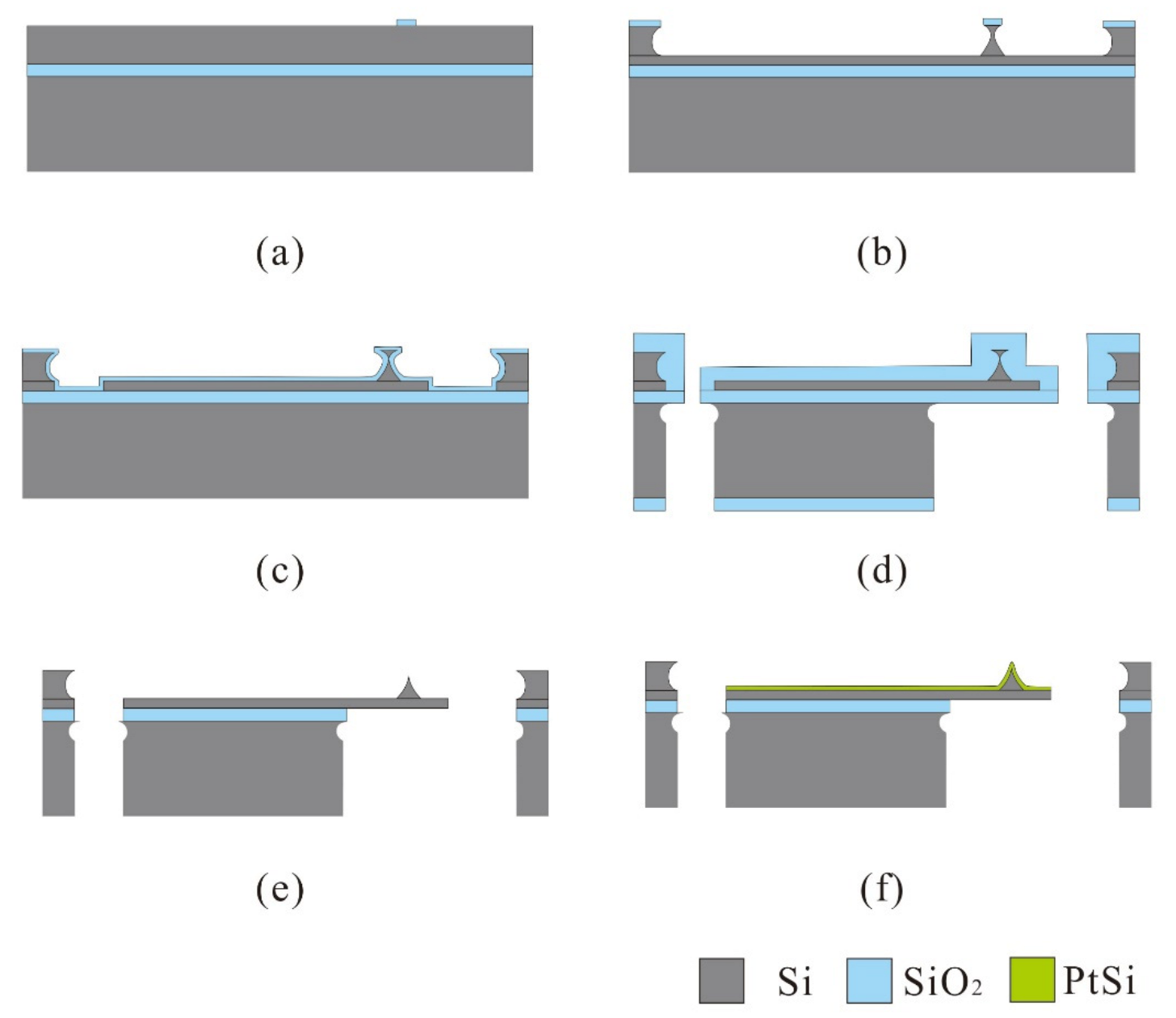
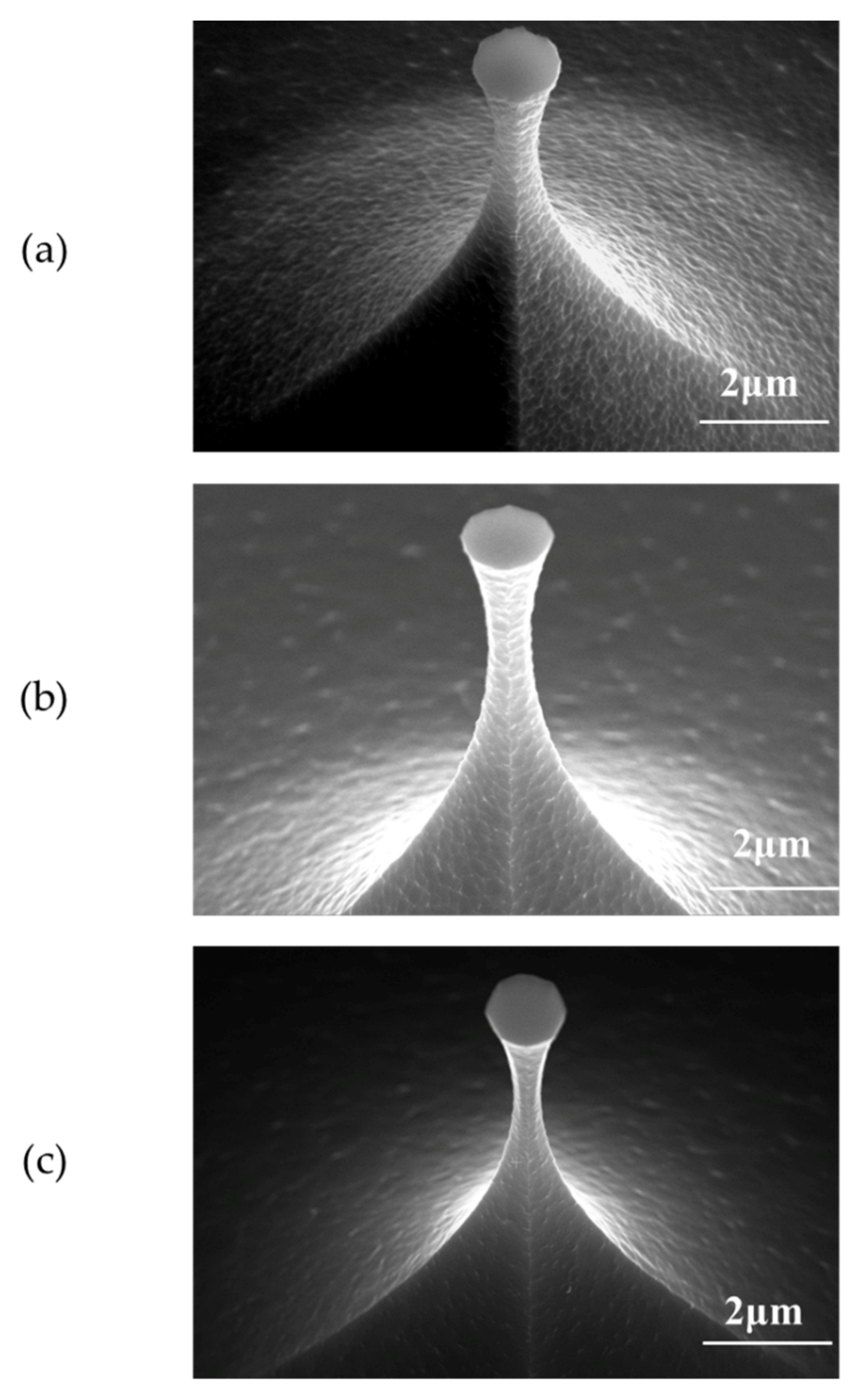
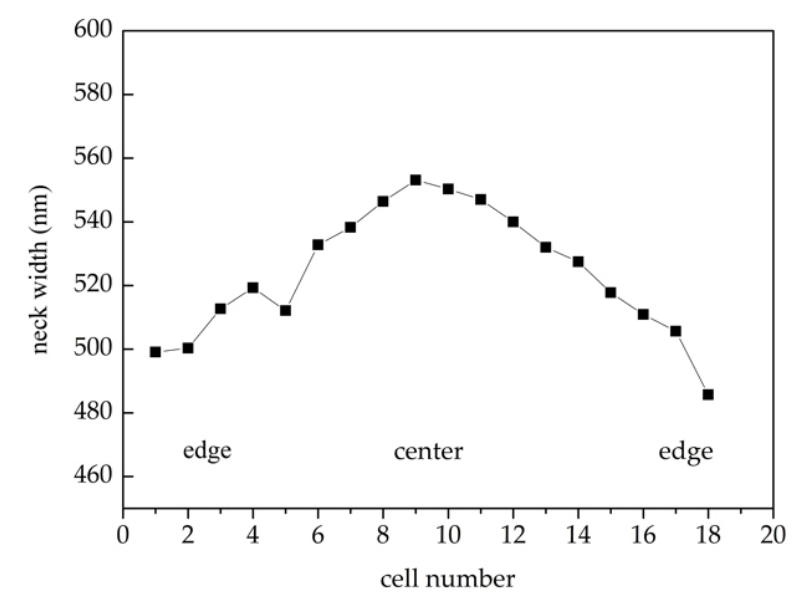

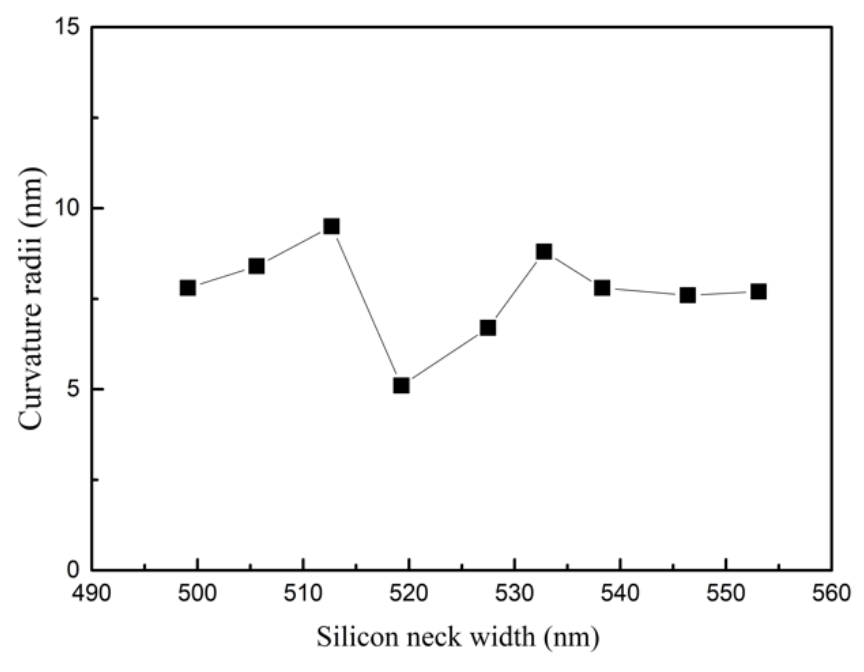
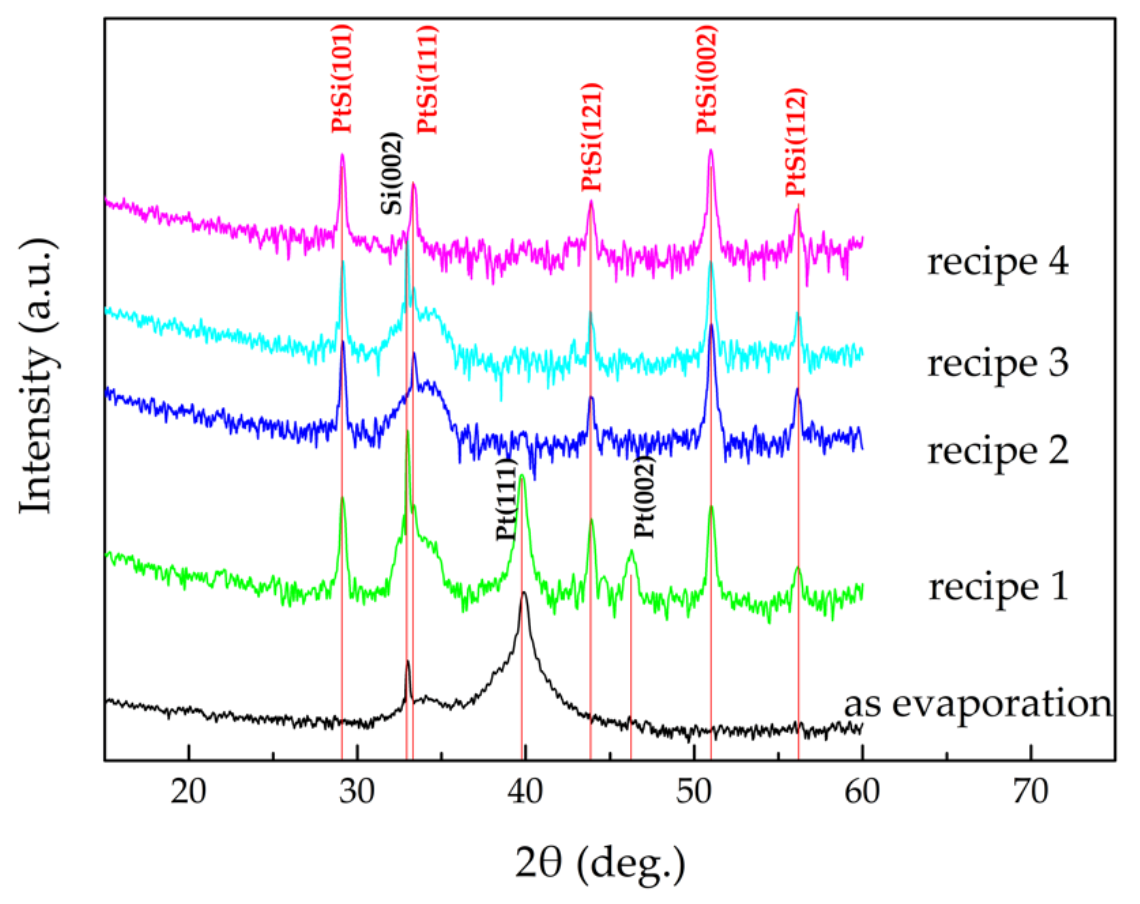

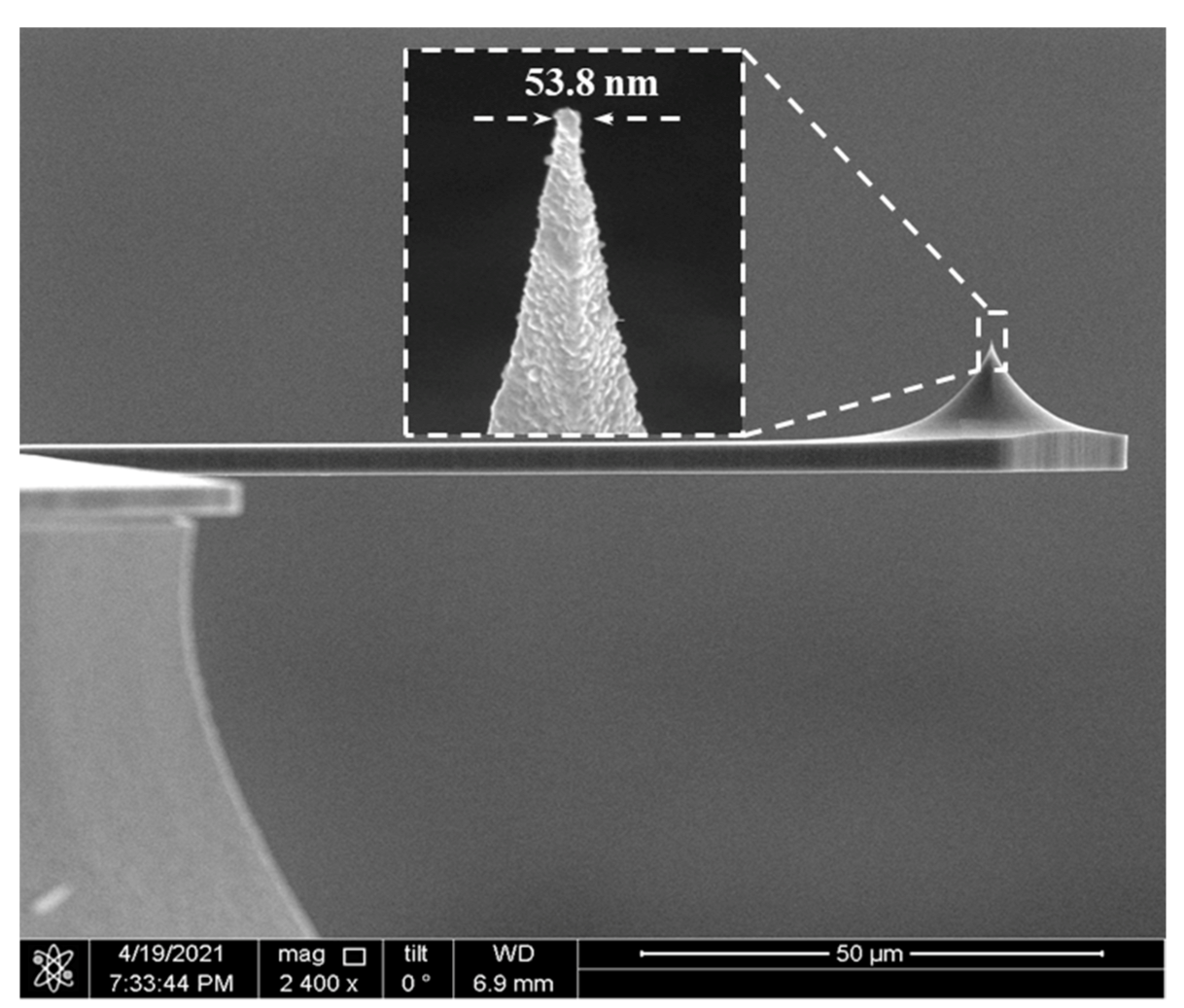

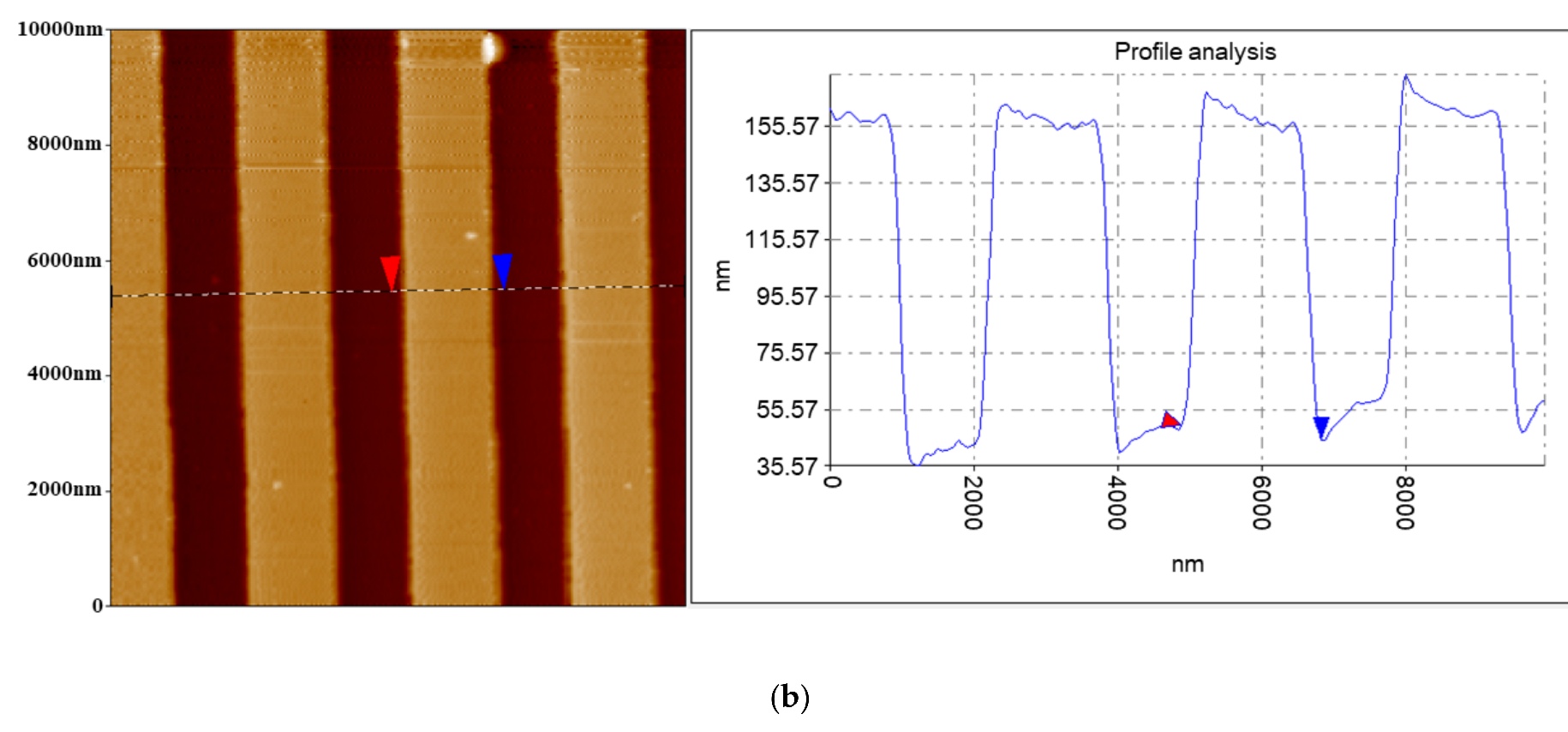

| Parameter | ICP Power (W/MHz) | SF6 Flow Rate (sccm) | Pressure (Pascal) | Etching Time (sec) | Neck Width (nm) |
|---|---|---|---|---|---|
| I | 1000/2 | 100 | 1.1 | 270 | 863 |
| II | 1000/2 | 100 | 1.3 | 267 | 701 |
| III | 1000/2 | 100 | 1.6 | 268 | 478 |
| Annealing Recipe | Annealing Atmosphere | Temperature/Time |
|---|---|---|
| 1 | N2 | 200–300–550 °C 10 min–10 min–90 min |
| 2 | N2:H2 = 5:1 | 200–300–550 °C 10 min–10 min–90 min |
| 3 | N2:H2 = 5:1 | 200–300–550 °C 10 min–10 min–60 min |
| 4 | N2:H2 = 5:1 | 200–300–500 °C 10 min–10 min–45 min |
Publisher’s Note: MDPI stays neutral with regard to jurisdictional claims in published maps and institutional affiliations. |
© 2021 by the authors. Licensee MDPI, Basel, Switzerland. This article is an open access article distributed under the terms and conditions of the Creative Commons Attribution (CC BY) license (https://creativecommons.org/licenses/by/4.0/).
Share and Cite
Liu, M.; Zhu, Y.; Zhao, J.; Wang, L.; Yang, J.; Yang, F. Batch Fabrication of Wear-Resistant and Conductive Probe with PtSi Tip. Micromachines 2021, 12, 1326. https://doi.org/10.3390/mi12111326
Liu M, Zhu Y, Zhao J, Wang L, Yang J, Yang F. Batch Fabrication of Wear-Resistant and Conductive Probe with PtSi Tip. Micromachines. 2021; 12(11):1326. https://doi.org/10.3390/mi12111326
Chicago/Turabian StyleLiu, Meijie, Yinfang Zhu, Junyuan Zhao, Lihao Wang, Jinling Yang, and Fuhua Yang. 2021. "Batch Fabrication of Wear-Resistant and Conductive Probe with PtSi Tip" Micromachines 12, no. 11: 1326. https://doi.org/10.3390/mi12111326
APA StyleLiu, M., Zhu, Y., Zhao, J., Wang, L., Yang, J., & Yang, F. (2021). Batch Fabrication of Wear-Resistant and Conductive Probe with PtSi Tip. Micromachines, 12(11), 1326. https://doi.org/10.3390/mi12111326





